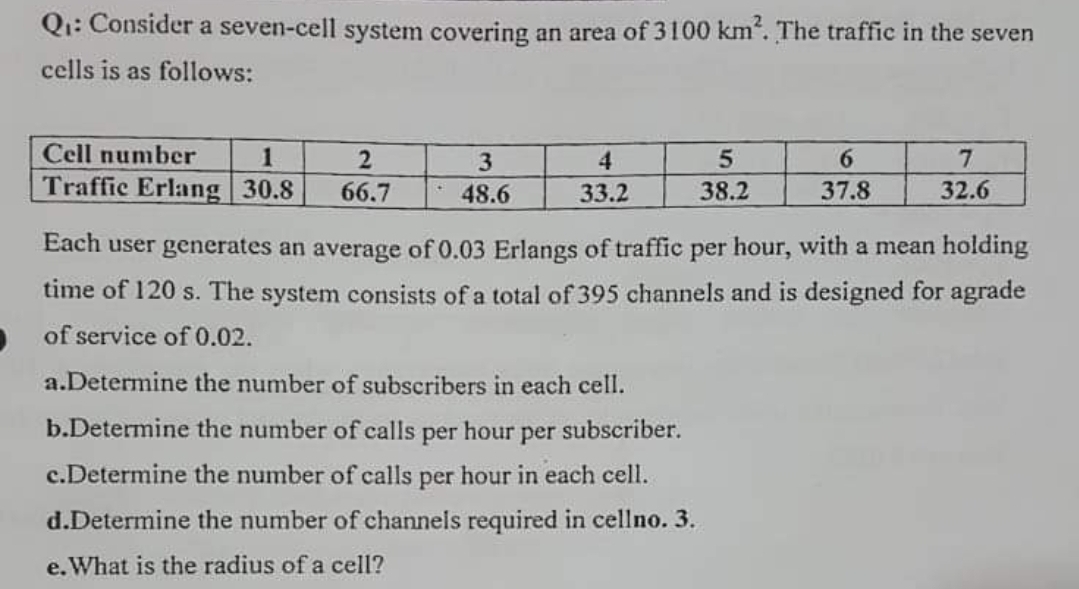Qi: Consider a seven-cell system covering an area of 3100 km. The traffic in the seven cells is as follows: Cell number 2. 4 9. Traffic Erlang 30.8 66.7 48.6 33.2 38.2 37.8 32.6 Each user generates an average of 0.03 Erlangs of traffic per hour, with a mean holding time of 120 s. The system consists of a total of 395 channels and is designed for agrade of service of 0.02. a.Determine the number of subscribers in each cell. b.Determine the number of calls per hour per subscriber. c.Determine the number of calls per hour in each cell.
Qi: Consider a seven-cell system covering an area of 3100 km. The traffic in the seven cells is as follows: Cell number 2. 4 9. Traffic Erlang 30.8 66.7 48.6 33.2 38.2 37.8 32.6 Each user generates an average of 0.03 Erlangs of traffic per hour, with a mean holding time of 120 s. The system consists of a total of 395 channels and is designed for agrade of service of 0.02. a.Determine the number of subscribers in each cell. b.Determine the number of calls per hour per subscriber. c.Determine the number of calls per hour in each cell.
Introductory Circuit Analysis (13th Edition)
13th Edition
ISBN:9780133923605
Author:Robert L. Boylestad
Publisher:Robert L. Boylestad
Chapter1: Introduction
Section: Chapter Questions
Problem 1P: Visit your local library (at school or home) and describe the extent to which it provides literature...
Related questions
Question
100%

Transcribed Image Text:Qi: Consider a seven-cell system covering an area of 3100 km“. The traffic in the seven
cells is as follows:
Cell number
4
9.
7.
Traffic Erlang 30.8
66.7
48.6
33.2
38.2
37.8
32.6
Each user generates an average of 0.03 Erlangs of traffic per hour, with a mean holding
time of 120 s. The system consists of a total of 395 channels and is designed for agrade
O of service of 0.02.
a.Determine the number of subscribers in each cell.
b.Determine the number of calls
per
hour
per subscriber.
c.Determine the number of calls per hour in each cell.
d.Determine the number of channels required in cellno. 3.
e. What is the radius of a cell?
Expert Solution
This question has been solved!
Explore an expertly crafted, step-by-step solution for a thorough understanding of key concepts.
This is a popular solution!
Trending now
This is a popular solution!
Step by step
Solved in 3 steps

Knowledge Booster
Learn more about
Need a deep-dive on the concept behind this application? Look no further. Learn more about this topic, electrical-engineering and related others by exploring similar questions and additional content below.Recommended textbooks for you

Introductory Circuit Analysis (13th Edition)
Electrical Engineering
ISBN:
9780133923605
Author:
Robert L. Boylestad
Publisher:
PEARSON

Delmar's Standard Textbook Of Electricity
Electrical Engineering
ISBN:
9781337900348
Author:
Stephen L. Herman
Publisher:
Cengage Learning

Programmable Logic Controllers
Electrical Engineering
ISBN:
9780073373843
Author:
Frank D. Petruzella
Publisher:
McGraw-Hill Education

Introductory Circuit Analysis (13th Edition)
Electrical Engineering
ISBN:
9780133923605
Author:
Robert L. Boylestad
Publisher:
PEARSON

Delmar's Standard Textbook Of Electricity
Electrical Engineering
ISBN:
9781337900348
Author:
Stephen L. Herman
Publisher:
Cengage Learning

Programmable Logic Controllers
Electrical Engineering
ISBN:
9780073373843
Author:
Frank D. Petruzella
Publisher:
McGraw-Hill Education

Fundamentals of Electric Circuits
Electrical Engineering
ISBN:
9780078028229
Author:
Charles K Alexander, Matthew Sadiku
Publisher:
McGraw-Hill Education

Electric Circuits. (11th Edition)
Electrical Engineering
ISBN:
9780134746968
Author:
James W. Nilsson, Susan Riedel
Publisher:
PEARSON

Engineering Electromagnetics
Electrical Engineering
ISBN:
9780078028151
Author:
Hayt, William H. (william Hart), Jr, BUCK, John A.
Publisher:
Mcgraw-hill Education,